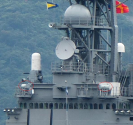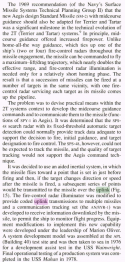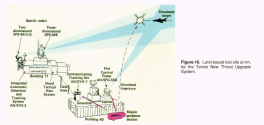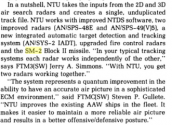The mountain wasn't the point. You can inverse the picture: put the radar at sea-level and the threat at altitude. The point was to demonstrate what the tracking and illumination capabilities of the upgraded SPG-51D are. Tracking a sea-skimming missile is a lot more challenging than tracking an aircraft flying at 1km+ altitude. If the SPG-51D was credited to be able to track and illuminate sea-skimming missiles at ranges well beyond 45nm=83.34km, then it would do even better against aircraft whose RCS is 10-100 larger than the missile and who don't fly as low.
First, it is SPG-51D Mod 15 NTU that is installed on the ROC Kidd's. Second, the plots in that pdf are authors's simulations where he plugged in his estimation of radar parameters into the radar equation. Judging by the range he gave to the SM-2MR he must've been used the early variant of the missile. The same could then be said of the SPG-51 radar.
The SM-2MR Blk III on the ROC Kidd have a range of 90nm and the ship's Tartar combat system received the NTU upgrade in the 88-90.
In AEGIS ships, the SPG-62 illuminators are slaved to SPY-1. On the Kidd, the SPG-51 needs to be able to track the target in order to point the illumination beam correctly, which happens automatically since they share the same antenna. Thanks to inertial guidance of SM-2 missiles, the tracking/illumination can still be timeshared among a large number of missiles, although less than in AEGIS for the reason discussed above. For the initial part of the engagement, the SPS-48 track is sufficient (otherwise it couldn't time share).
You keep running into contradictions. We just saw in the example above that SPG-51D is capable of engaging small sea-skimming missiles at a distance of well beyond 45nm ( if positioned at a mountaintop). Against aircraft with RCS up to 100 larger it should theoretically be able to do triple that (quadratic root relation of range to RCS).
Your argument is basically that ROC's Kidd destroyer and F-16 fighter are mismatched to their anti-air weapons of choice and can't take advantage of the full capability of the SM-2MR Block IIIA missile and the AIM-120C-7 missile, respectively. On the other hand, you claim that the PRC's Sovremmeny destroyers and J-10 aircraft are perfectly matched to their weapon of choice. Please.
SPG-51D has enough illumination power. As discussed previously, it has a slightly larger antenna and 40% of the output RF power compared to SPG-62. Increasing power output by 60% will give you 26% more illumination range (square root relation). The latter's minimum illumination capability is 240km, which is the range of the SM-2ER Block IV missile, but is likely even more as it supports the longer range SM-6. Taking 240km as the baseline, we can derive the SPG-51D max illumination range to be 190km.
Finally, I guess you know that modern SAM's don't fly the shortest path from A to B? In fact, not flying the straight line to target is what gives them ultimately more range due to superior aerodynamics.
The picture isn't at scale, and you might as well assume the slant range of the SPG-51 to the target is maybe about 70km or less given the Tico's radar horizon might be around 30km.
SPS-48 problem is that it can only track what is in front of the array, not its back. Dual backing not only doubles the rate of update, it also covers double the volume.
Going back to the SPS-48, the length of its S feed also means it takes a relatively longer time for the signal to go from one end of the feed to the other. That increases the length of time to do a scan, which means slower vertical scan, so longer time between tracks. That's the point of some radars having shorter S-feeds.
With regards to the F-16 why did you switch the argument from AIM-7 to the AIM-120C7? ARH missiles can compensate for the distance because of the seeker's terminal range. Its your inertial+midphase+terminal range total. AIM-120 doesn't use the X-band CWI illuminator either. The X-band illuminator is special only for the ROC's APG-66 to make the radar compatible with the ROC's existing stock of Sparrows.
You keep on going back to the time sharing. It does not matter that much because you only have two illuminators. You cannot put too many missiles in the sky because missiles cannot loiter, and if a missile is "waiting" for the next target, it still consumes its fuel and it may end up in a position that is unfavorable for intercepting a new target when the position of the new target is discovered. And then you have an issue with the datalinks. These are not magic. Where and what's your antenna that is used to work for this? If its omnidirectional, you have a problem that enemy EW will discover the signal and jam it. If its omnidirectional, you won't have high gain and your range is limited. If the datalink is directional, in order to hide from enemy EW and gain range, where is the high gain antenna then? Usually the best place is to put it in the radar itself, so it shares the same dish. You don't have to sync a separate high gain antenna. However, putting it on the same dish means the missile will have to be in the same beamwidth of the radar to obtain that signal. Also with mechanical high gain antennas, that's one antenna per missile and it still needs to continually track the missile. How many datalinks can you see on the Kidd? This is another point of using a phase array and putting the datalink into it.
Once again, you keep on claiming despite the declassified .mil document that says otherwise. Oh you think the plot is made by calculations and not from actual testing? Where is your basis on that? Do you have any details on the NTU upgrade that suggest they changed the illumination transmitter from the 4kw?
You're making range calculations without taking account of the radar's antenna gain, target radar cross section and the missile's minimum receivable signal? Even if you reach that far, that's not the point. The point is the strength of the reflection
from the target versus the size, gain, and the minimum receivable signal on the
missile antenna that the missile will accept as a lock.





